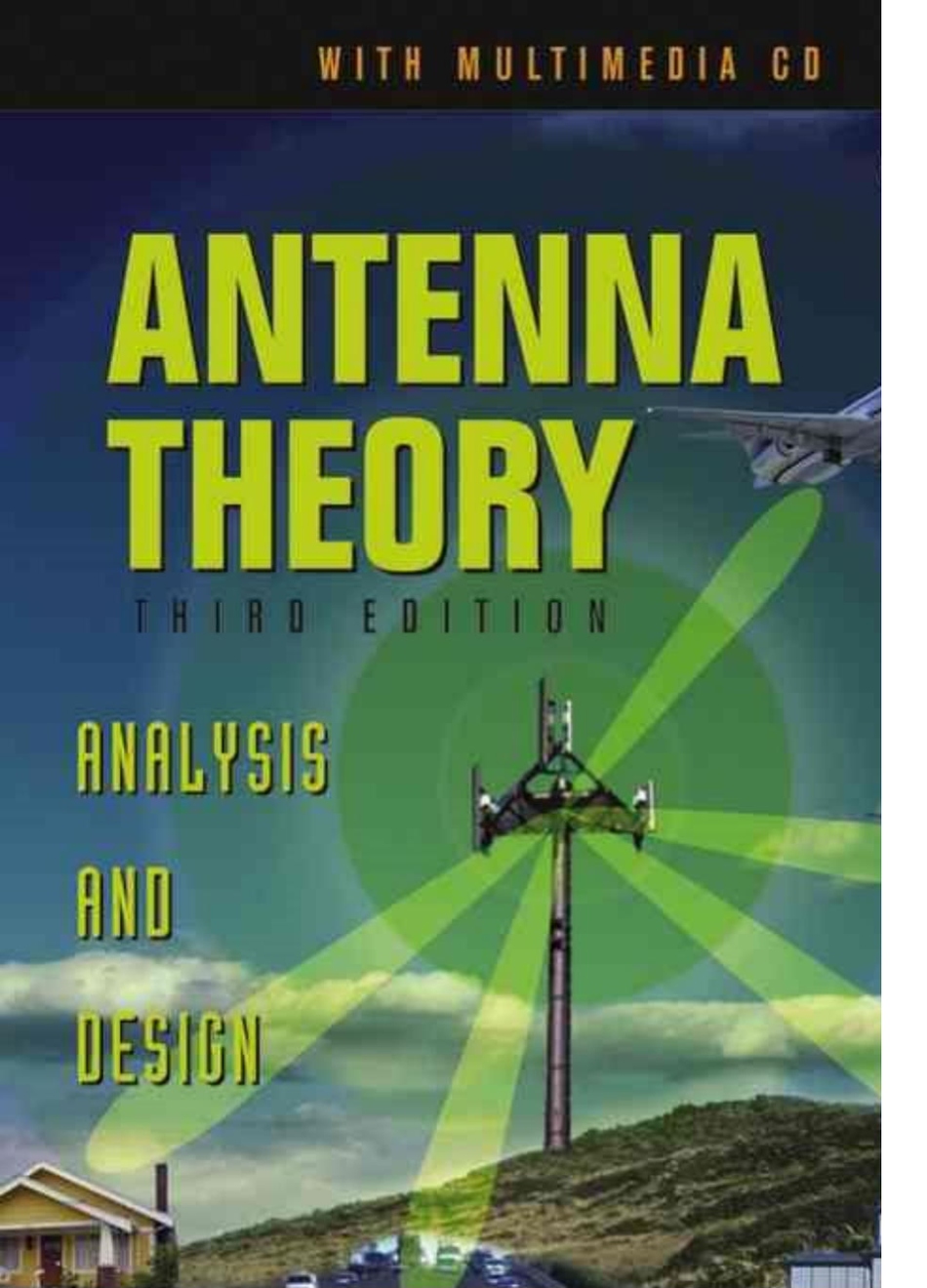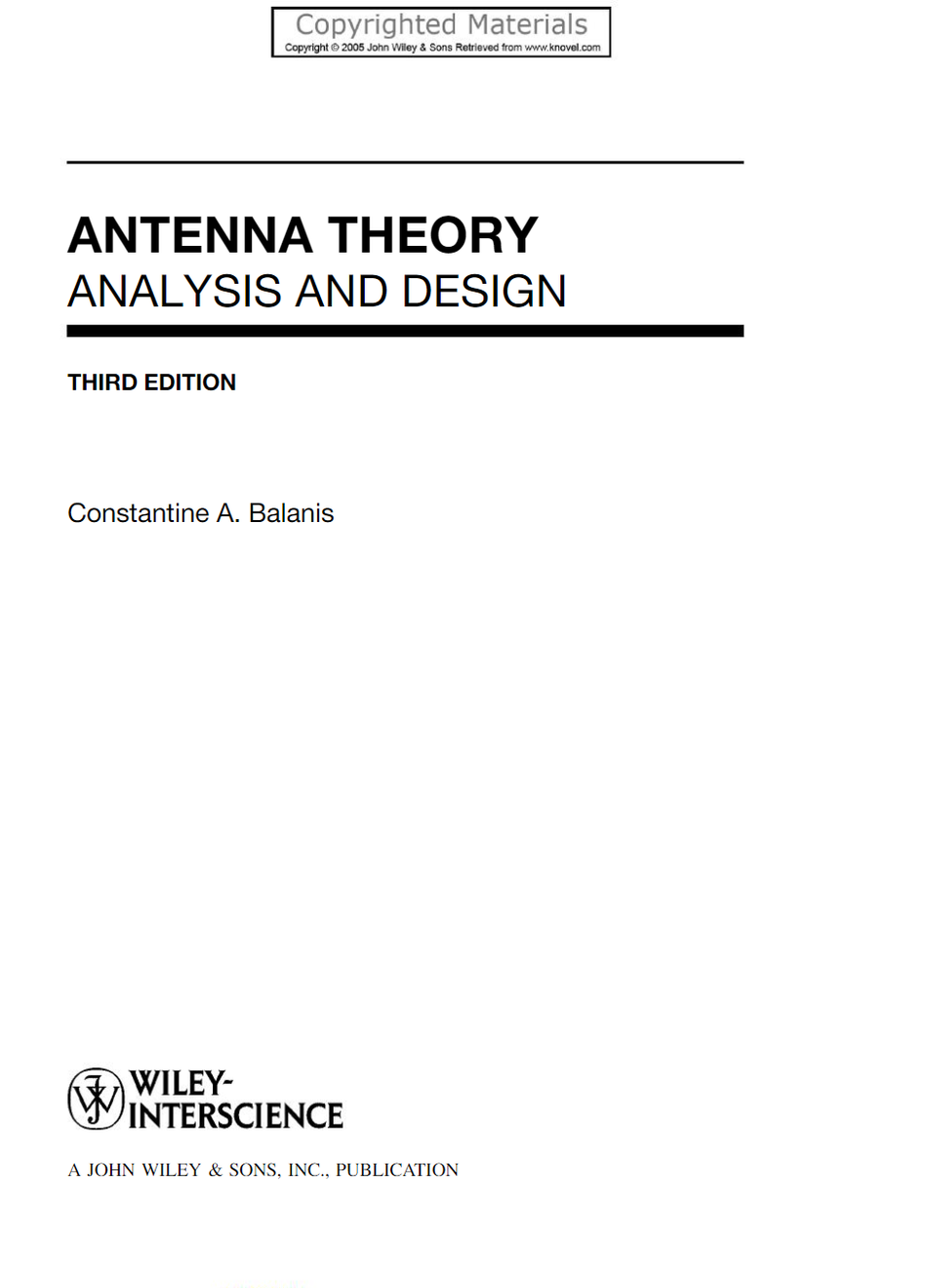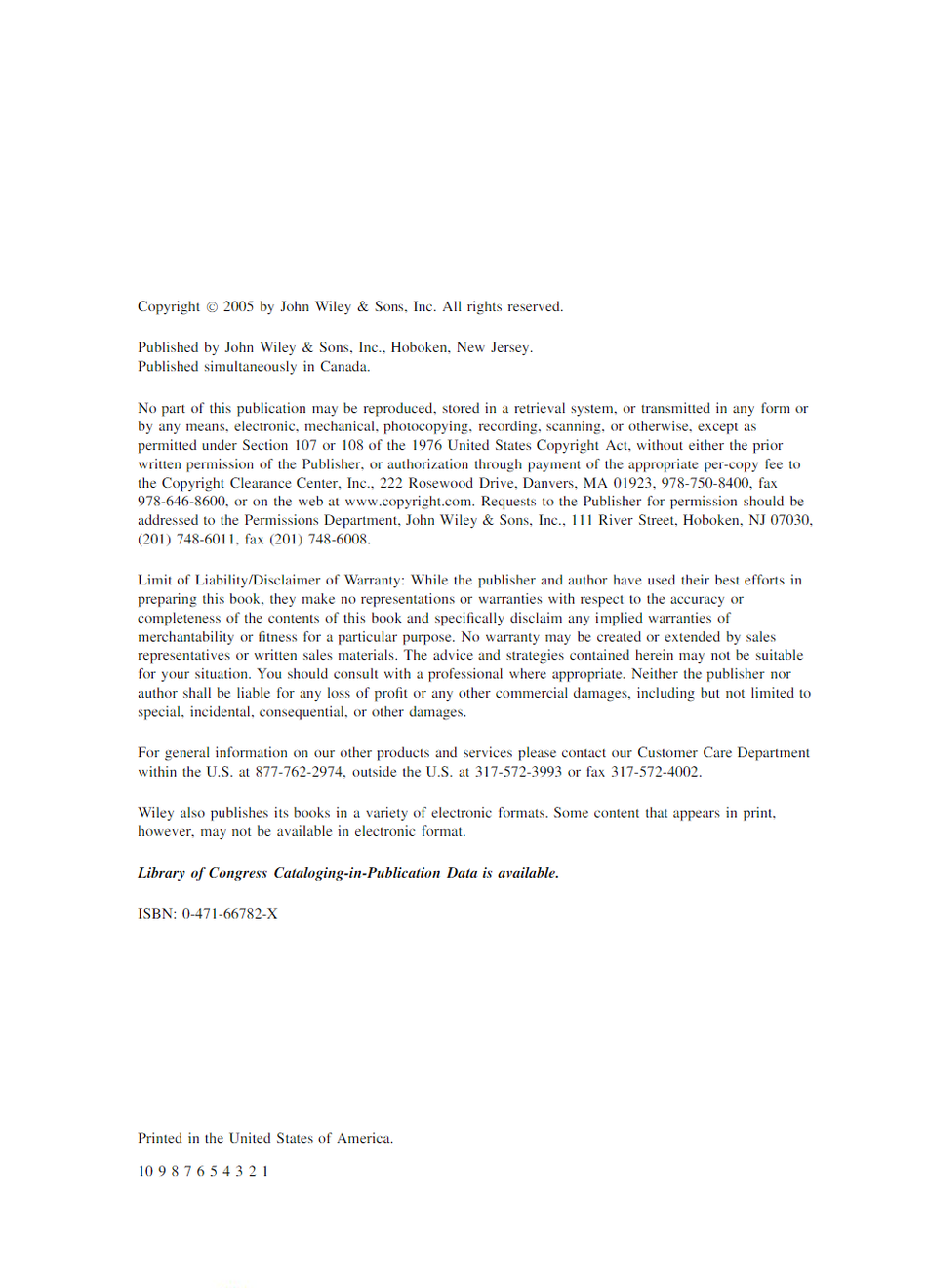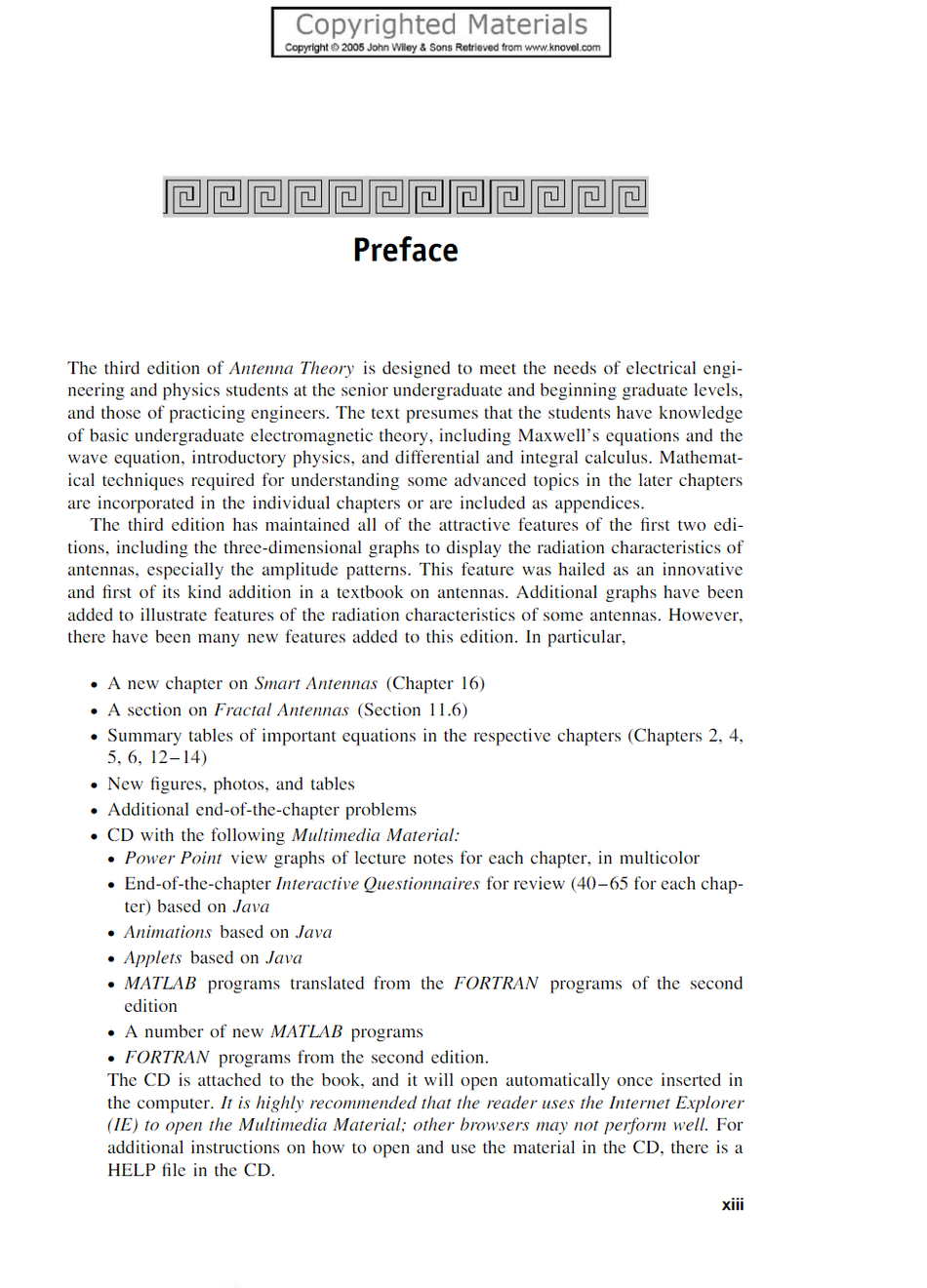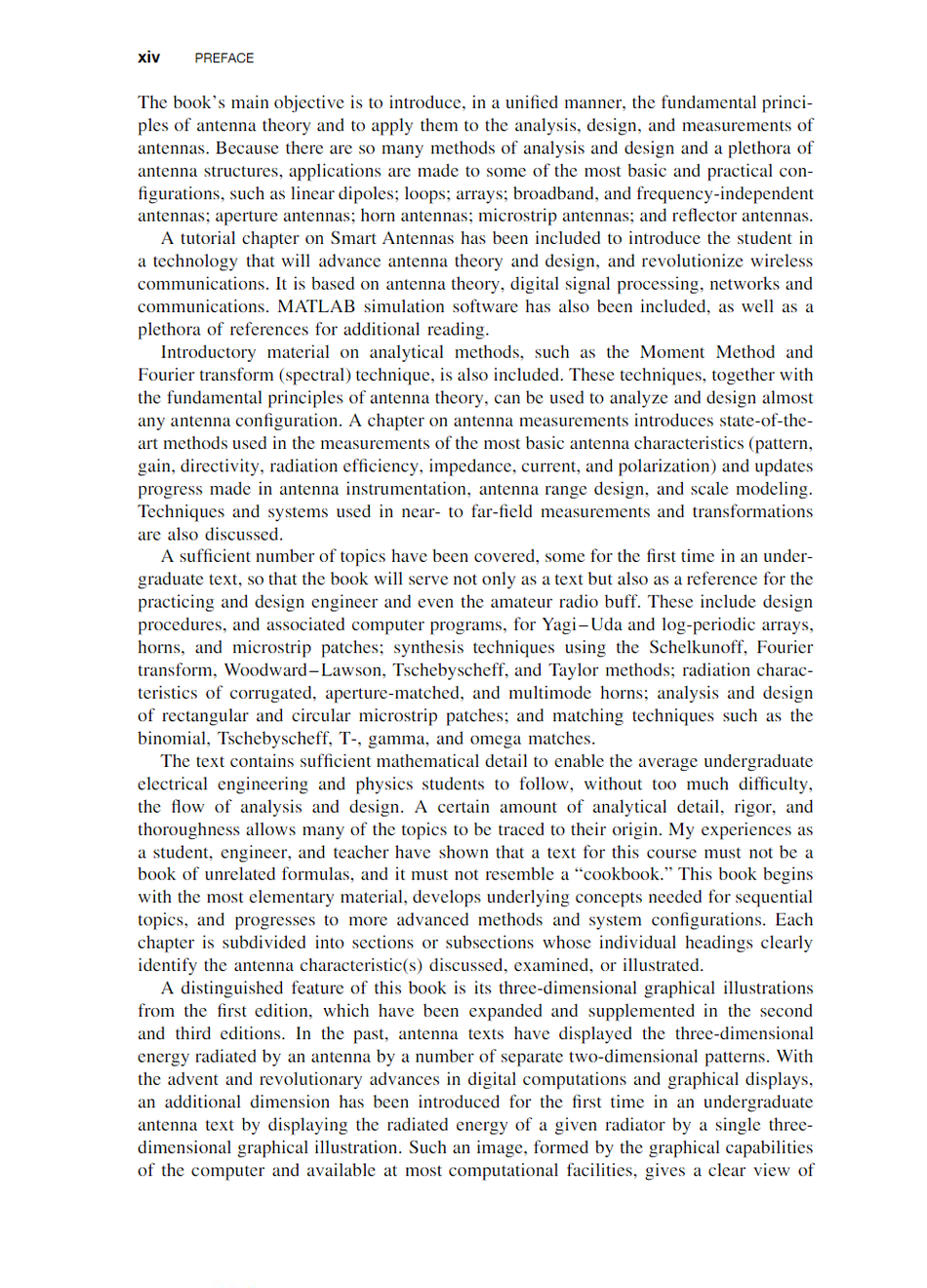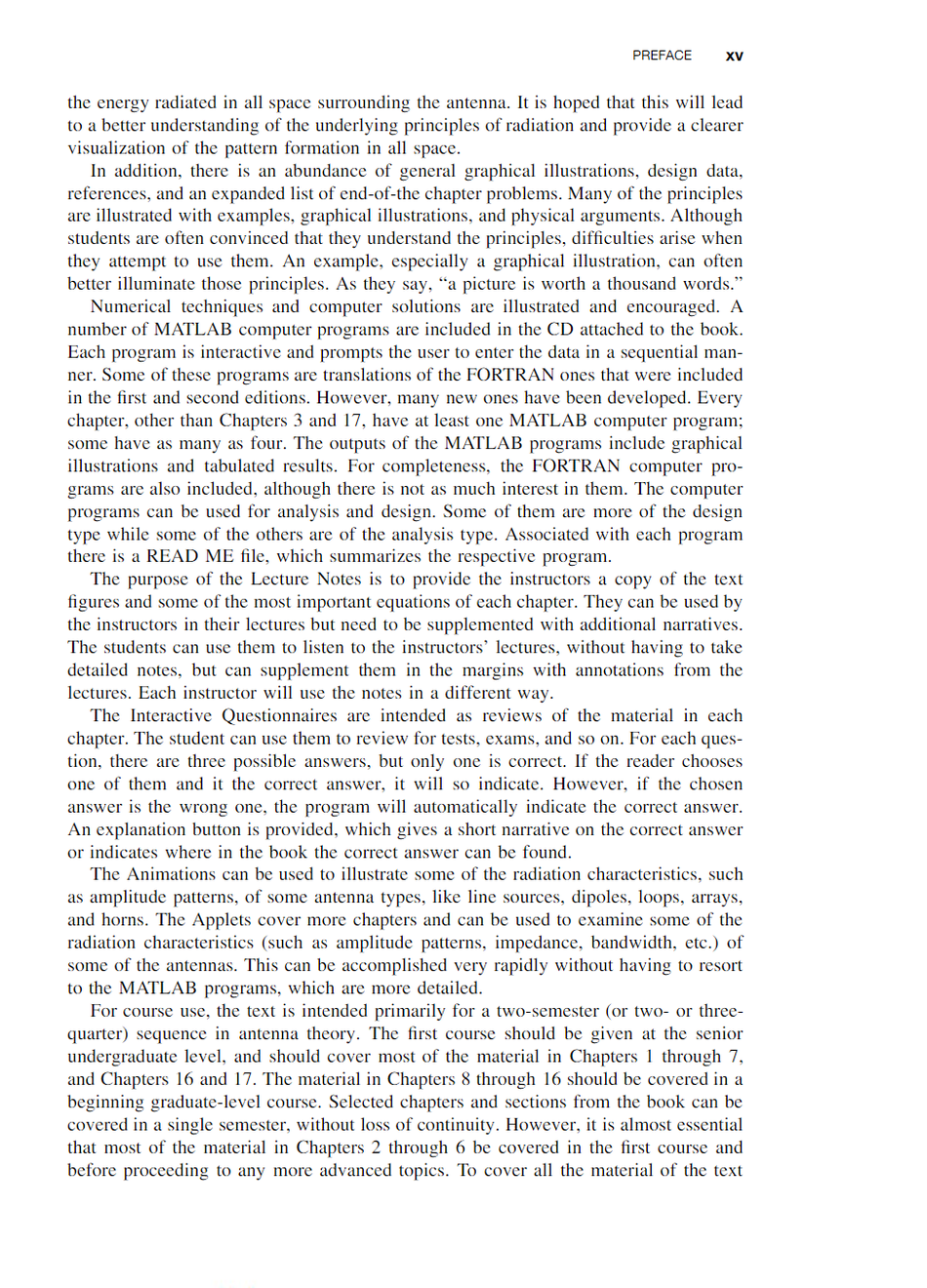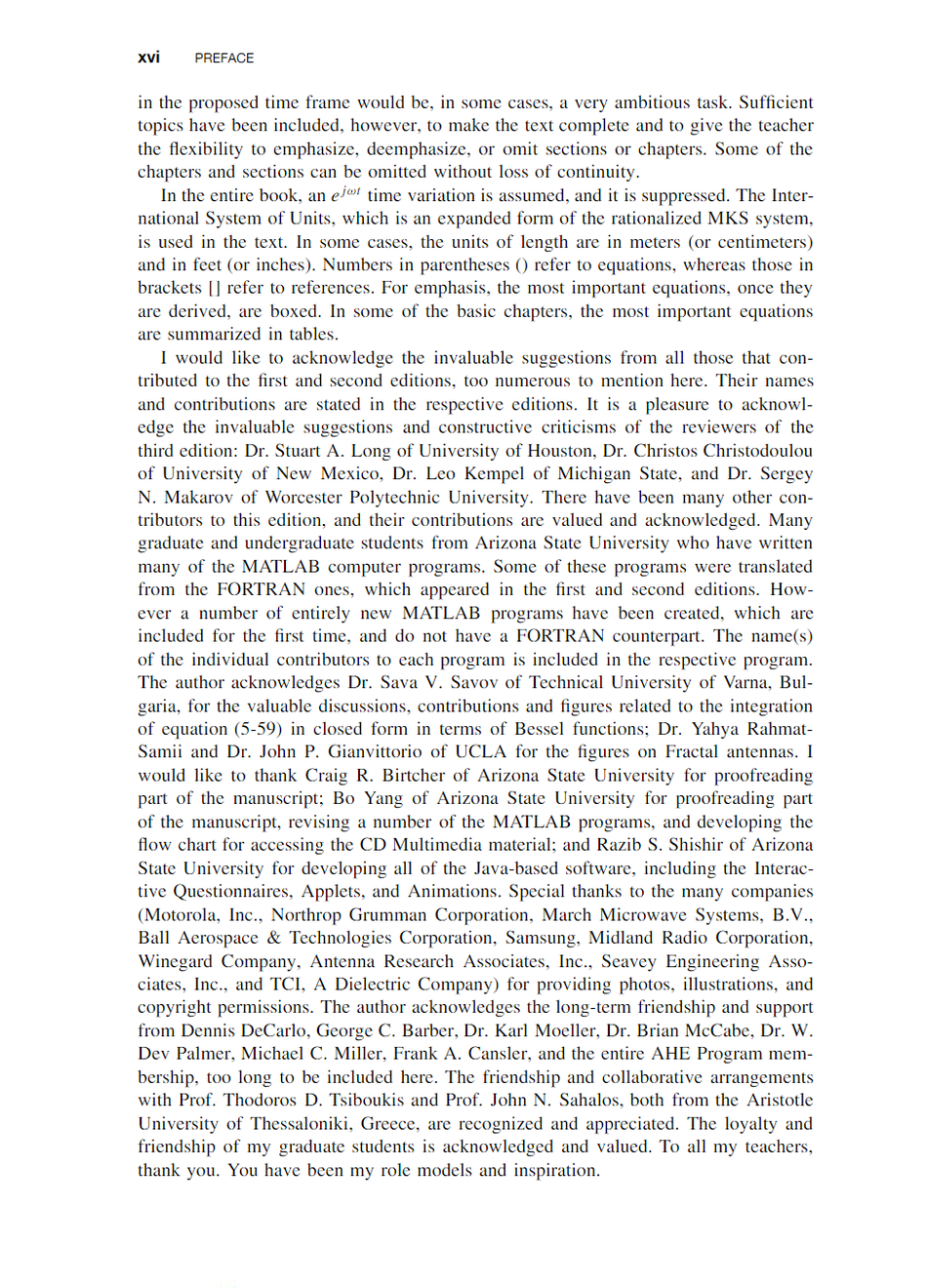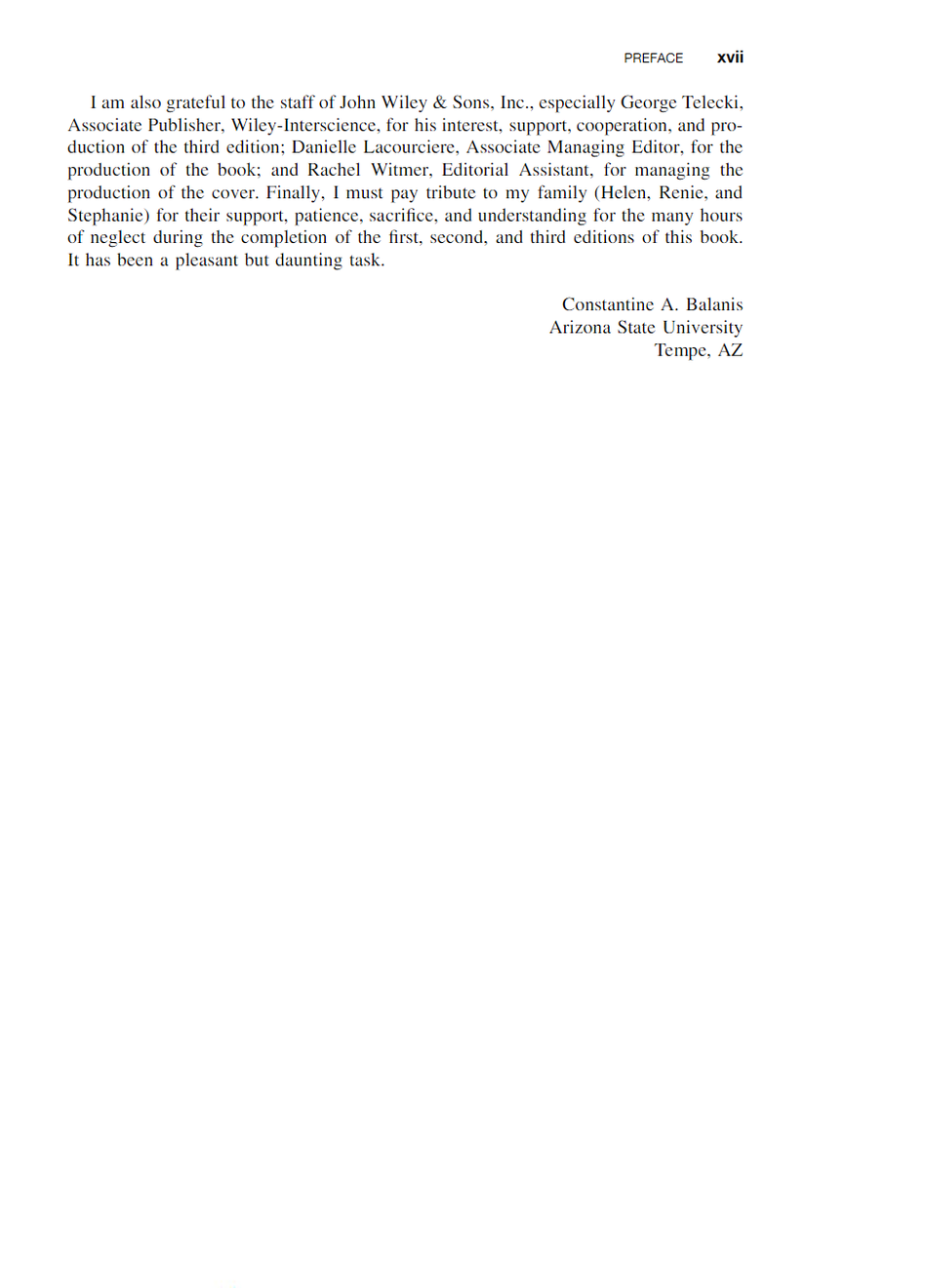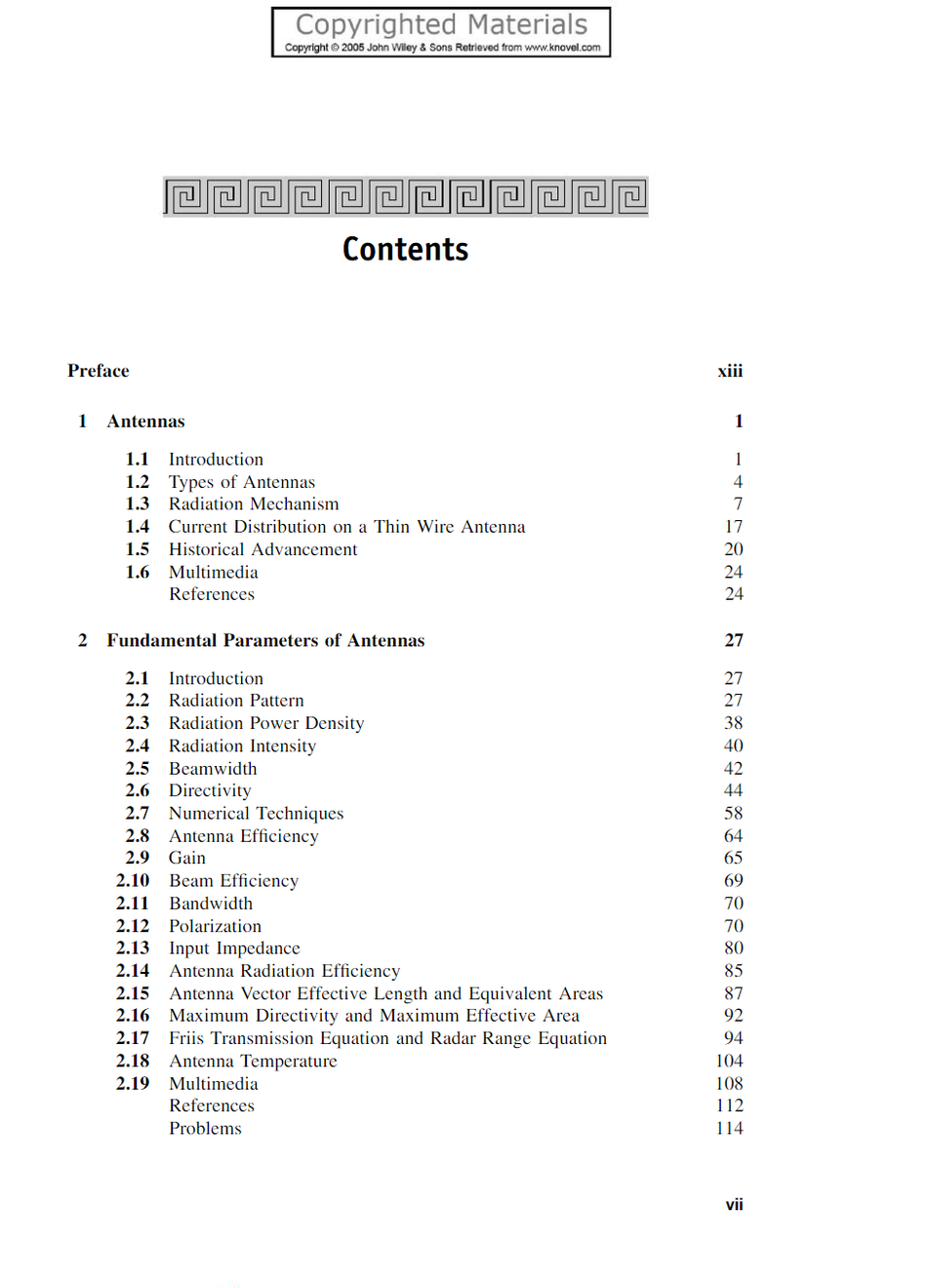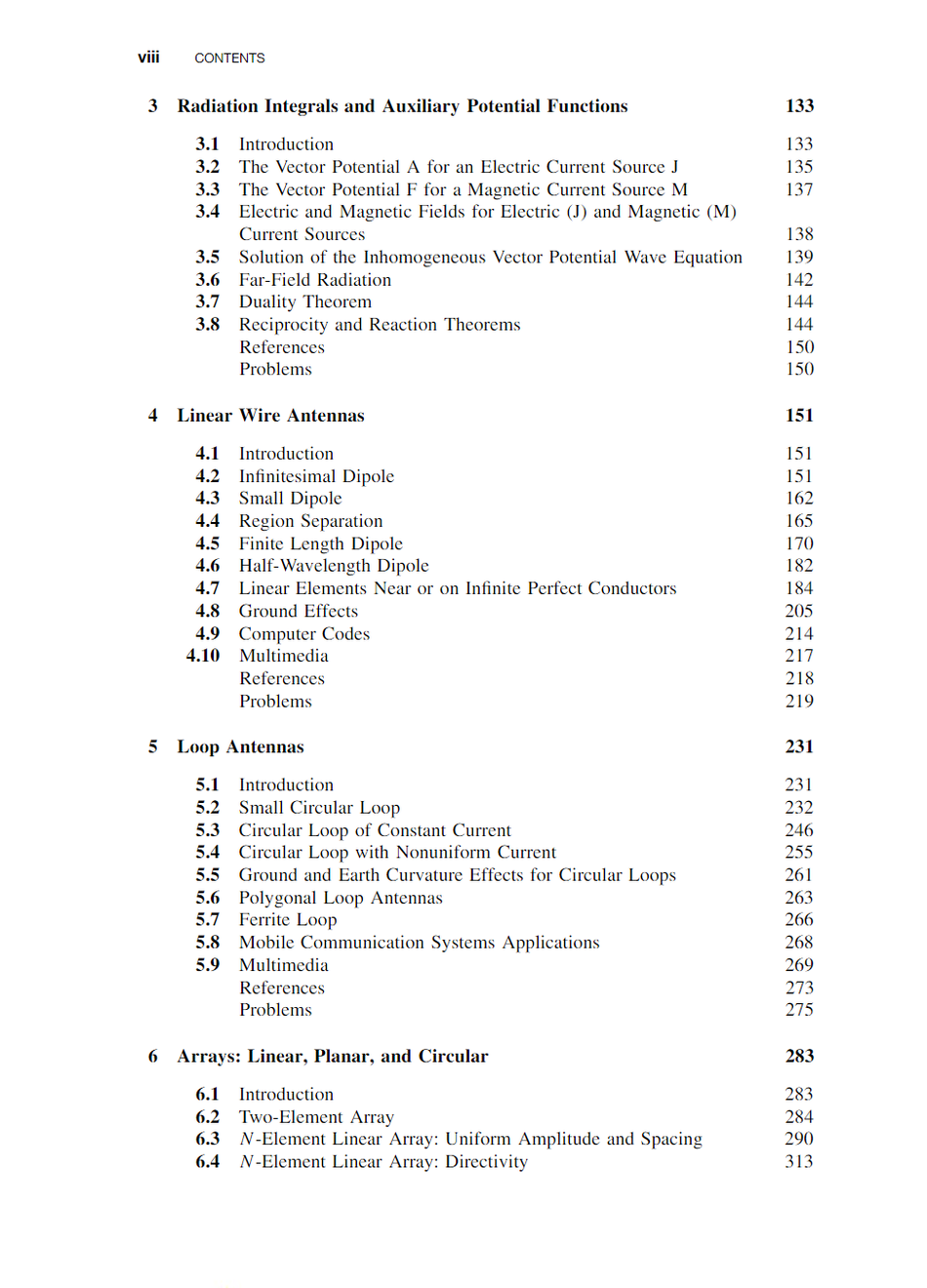天线理论设计与分析
天线设计的一本经典书籍,讲述了天线的理论推导以及各种天线的设计过程。Copyright o 2005 by John Wiley sons, Inc. All rights reservedPublished by John Wiley sons, Inc, Hoboken, New JerseyPublished simultaneously in Canadaby any means, electronic, mechanical, photocopying, recording, scanning, or otherwise, except d orm orNo part of this publication may be reproduced, stored in a retrieval system, or transmitted in anypermitted under Section 107 or 108 of the 1976 United States Copyright Act, without either the priorwritten permission of the Publisher, or authorization through payment of the appropriate per-copy fee tothe Copyright Clearance Center, Inc, 222 Rosewood Drive, Danvers, MA O1923, 978-750-8400, fax978-646-8600,oronthewebatwww.copyright.com.RequeststothePublisherforpermissionshouldbeaddressed to the Permissions Department, John Wiley sons, Inc, 111 River Street, Hoboken, NJ 07030(201)748-6011,fax(201)748-6008Limit of liability/Disclaimer of warranty: while the publisher and author have used their best efforts inpreparing this book, they make no representations or warranties with respect to the accuracy orcompleteness of the contents of this book and specifically disclaim any implied warranties ofmerchantability or fitness for a particular purpose. No warranty may be created or extended by salesepresentatives or written sales materials. The advice and strategies contained herein may not be suitablefor your situation. You should consult with a professional where appropriate. Neither the publisher norauthor shall be liable for any loss of profit or any other commercial damages, including but not limited tospecial, incidental, consequential, or other damagesFor general information on our other products and services please contact our Customer Care Departmentwithin the U.s. at 877-762-2974 outside the U.S. at 317-572-3993 or fax 317-572-4002Wiley also publishes its books in a variety of electronic formats. Some content that appears in print,however, may not be available in electronic formatLibrary of Congress Cataloging-in-Publication Data is availableISBN:0-471-66782-XPrinted in the United States of america10987654321Copyrighted materialsCopyright@2005JohnwIley&SonsRetrievedfromwww.knovel.com回回回回回回回回回回回回PrefaceThe third edition of Antenna Theory is designed to meet the needs of electrical engi-neering and physics students at the senior undergraduate and beginning graduate levels,ld those of practicing engineers. The text presumes that the students have knowledgeof basic undergraduate electromagnetic theory, including Maxwells equations and thewave equation, introductory physics, and differential and integral calculus Mathemat-ical techniques required for understanding some advanced topics in the later chaptersare incorporated in the individual chapters or are included as appendicesThe third edition has maintained all of the attractive features of the first two editions, including the three-dimensional graphs to display the radiation characteristics ofantennas, especially the amplitude patterns. This feature was hailed as an innovativeand first of its kind addition in a textbook on antennas. Additional graphs have beenadded to illustrate features of the radiation characteristics of some antennas. Howeverthere have been many new features added to this edition. In particular,A new chapter on Smart Antennas( Chapter 16)A section on Fractal Antennas(Section 11.6Summary tables of important equations in the respective chapters( Chapters 2, 45,6,12-14)New figures, photos, and tablesAdditional end-of-the-chapter problemsCD with the following multimedia materialPower Point view graphs of lecture notes for each chapter, in multicolorEnd-of-the-chapter Interactive Questionnaires for review(40-65 for each chap-ter) based on Javaanimations based on javaapplets based on JavaMATLAB programs translated from the FOrTRAN programs of the secondeditionA number of new MATLAB programsFORTRAN Programs from the second editionThe Cd is attached to the book, and it will open automatically once inserted inthe computer. It is highly recommended that the reader uses the Internet Explorer(E)to open the Multimedia Material; other browsers may not perform well. Foradditional instructions on how to open and use the material in the cd there is ahELP file in the cDXIV PREFACEThe book's main objective is to introduce in a unified manner, the fundamental principles of antenna theory and to apply them to the analysis, design, and measurements ofantennas. because there are so many methods of analysis and design and a plethora ofantenna structures, applications are made to some of the most basic and practical configurations, such as linear dipoles; loops; arrays; broadband, and frequency-independentantennas; aperture antennas; horn antennas; microstrip antennas; and reflector antennasa tutorial chapter on Smart Antennas has been included to introduce the student ina technology that will advance antenna theory and design, and revolutionize wirelesscommunications. It is based on antenna theory, digital signal processing, networks andcommunications. MAtLab Simulation software has also been included. as well as aplethora of references for additional readingIntroductory material on analytical methods such as the moment method andFourier transform(spectral) technique, is also included. These techniques, together withthe fundamental principles of antenna theory, can be usedlyze and design almostany antenna configuration. A chapter on antenna measurements introduces state-of-theart methods used in the measurements of the most basic antenna characteristics(pattern,gain, directivity, radiation efficiency, impedance, current, and polarization) and updatesprogress made in antenna instrumentation, antenna range design, and scale modelingTechniques and systems used in near-to far-field measurements and transformationsare also discussedA sufficient number of topics have been covered some for the first time in an undergraduate text, so that the book will serve not only as a text but also as a reference for thepracticing and design engineer and even the amateur radio buff. These include designprocedures, and associated computer programs, for Yagi-Uda and log-periodic arrayshorns, and microstrip patches; synthesis techniques using the Schelkunoff, Fouriertransform, Woodward-Lawson, Tschebyscheff, and Taylor methods; radiation charac-teristics of corrugated, aperture-matched, and multimode horns; analysis and designof rectangular and circular microstrip patches; and matching techniques such as thebinomial, Tschebyscheff, T-, gamma, and omega matchesThe text contains sufficient mathematical detail to enable the average undergraduateelectrical engineering and physics students to follow, without too much difficultythe flow of analysis and design. A certain amount of analytical detail, rigor, andthoroughness allows many of the topics to be traced to their origin. My experiences asa student, engineer, and teacher have shown that a text for this course must not be abook of unrelated formulas, and it must not resemble a"cookbook This book beginswith the most elementary material, develops underlying concepts needed for sequentialtopics, and progresses to more advanced methods and system configurations. Eachchapter is subdivided into sections or subsections whose individual headings clearlyidentify the antenna characteristic(s)discussed, examined, or illustrateda distinguished feature of this book is its three-dimensional graphical illustrationsfrom the first edition, which have been expanded and supplemented in the secondand third editions. In the past, antenna texts have displayed the three-dimensionaenergy radiated by an antenna by a number of separate two-dimensional patterns. Withthe advent and revolutionary advances in digital computations and graphical displayan additional dimension has been introduced for the first time in an undergraduateantenna text by displaying the radiated energy of a given radiator by a single threedimensional graphical illustration. Such an image, formed by the graphical capabilitiesof the computer and available at most computational facilities gives a clear view ofPREFACEthe energy radiated in all space surrounding the antenna. It is hoped that this will leadto a better understanding of the underlying principles of radiation and provide a clearervisualization of the pattern formation in all spaceIn addition, there is an abundance of general graphical illustrations, design datareferences, and an expanded list of end-of-the chapter problems. Many of the principlesare illustrated with examples, graphical illustrations, and physical arguments. Althoughstudents are often convinced that they understand the principles, difficulties arise whenthey attempt to use them. An example, especially a graphical illustration, can oftenbetter illuminate those principles. As they say, a picture is worth a thousand wordsNumerical techniques and computer solutions are illustrated and encouraged. anumber of matLAB computer programs are included in the Cd attached to the bookEach program is interactive and prompts the user to enter the data in a sequential manner. Some of these programs are translations of the fortran ones that were includedin the first and second editions. However, many new ones have been developed. Everychapter, other than Chapters 3 and 17, have at least one MatlaB computer programsome have as many as four The outputs of the matlab programs include graphicalillustrations and tabulated results. For completeness, the FORTRaN computer pro-grams are also included, although there is not as much interest in them. The computerprograms can be used for analysis and design. Some of them are more of the designtype while some of the others are of the analysis type. Associated with each programthere is a READ ME file, which summarizes the respective programThe purpose of the lecture Notes is to provide the instructors a copy of the textfigures and some of the most important equations of each chapter. They can be used bythe instructors in their lectures but need to be supplemented with additional narrativesThe students can use them to listen to the instructors'lectures, without having to takedetailed notes, but can supplement them in the margins with annotations from thelectures. Each instructor will use the notes in a different way.The Interactive Questionnaires are intended as reviews of the material in eachchapter. The student can use them to review for tests, exams, and so on. For each question, there are three possible answers but only one is correct. If the reader choosesone of them and it the correct answer it will so indicate. however if the chosenanswer is the wrong one the program will automatically indicate the correct answerAn explanation button is provided, which gives a short narrative on the correct answeror indicates where in the book the correct answer can be foundThe animations can be used to illustrate some of the radiation characteristics suchas amplitude patterns, of some antenna types, like line sources, dipoles, loops, arraysand horns. The Applets cover more chapters and can be used to examine some of theradiation characteristics(such as amplitude patterns, impedance, bandwidth, etc. ofsome of the antennas. This can be accomplished very rapidly without having to resortto the matlab programs, which are more detailedFor course use, the text is intended primarily for a two-semester (or two-or threequarter) sequence in antenna theory. The first course should be given at the seniorundergraduate level, and should cover most of the material in Chapters 1 through 7and Chapters 16 and 17. The material in Chapters 8 through 16 should be covered in abeginning graduate-level course Selected chapters and sections from the book can becovered in a single semester without loss of continuity However, it is almost essentialthat most of the material in Chapters 2 through 6 be covered in the first course andbefore proceeding to any more advanced topics. To cover all the material of the textPREFACEin the proposed time frame would be, in some cases, a very ambitious task. suffietopics have been included, however, to make the text complete and to give the teacherthe flexibility to emphasize, deemphasize or omit sections or chapters Some of thechapters and sections can be omitted without loss of continuityIn the entire book, an e Jot time variation is assumed, and it is suppressed The International System of Units, which is an expanded form of the rationalized mKs system,is used in the text. In some cases, the units of length are in meters (or centimetersand in feet (or inches). Numbers in parentheses o refer to equations, whereas those inbrackets refer to references For emphasis, the most important equations, once theyare derived are boxed. In some of the basic chapters, the most important equationsare summarized in tablesI would like to acknowledge the invaluable suggestions from all those thatcon-tributed to the first and second editions too numerous to mention here Their namesand contributions are stated in the respective editions. It is a pleasure to acknowledge the invaluable suggestions and constructive criticisms of the reviewers of thethird edition: Dr Stuart A Long of University of Houston, Dr. Christos Christodoulouof University of New Mexico, Dr. Leo Kempel of Michigan State, and Dr. SergeyN. Makarov of Worcester Polytechnic University. There have been many other contributors to this edition, and their contributions are valued and acknowledged. Manygraduate and undergraduate students from Arizona State University who have writtenmany of the matlaB computer programs. Some of these programs were translatedfrom the FORTRan ones, which appeared in the first and second editions. How-ever a number of entirely new MaTLAB programs have been created, which areincluded for the first time, and do not have a FORTRaN counterpart. The name(s)of the individual contributors to each program is included in the respective programThe author acknowledges Dr Sava v. Savov of Technical University of Varna, Bul-garia, for the valuable discussions, contributions and figures related to the integrationof equation(5-59)in closed form in terms of Bessel functions; Dr. Yahya rahmat-Samii and Dr. John P. gianvittorio of ucla for the figures on Fractal antennas. Iwould like to thank Craig R. Birtcher of Arizona State University for proofreadingpart of the manuscript; Bo Yang of Arizona State University for proofreading partof the manuscript, revising a number of the matlab programs, and developing theflow chart for accessing the cd multimedia material and razib s. shishir of arizonaState University for developing all of the Java-based software, including the Interactive Questionnaires, Applets, and Animations. Special thanks to the many companies(Motorola, InC, Northrop Grumman Corporation, March Microwave Systems, BVBall aerospace technologies Corporation, Samsung, Midland Radio Corporation,Winegard Company, Antenna Research Associates, Inc, Seavey Engineering ASSo-ciates, InC, and TCl, A Dielectric Company) for providing photos, illustrations, andcopyright permissions. The author acknowledges the long-term friendship and supportfrom Dennis De Carlo, George C. Barber, Dr. Karl moeller, Dr Brian McCabe, Dr. WDev Palmer, Michael C. Miller, Frank A. Cansler, and the entire AhE Program mem-bership, too long to be included here. The friendship and collaborative arrangementswith Prof. Thodoros d. tsiboukis and prof, John n. sahalos both from the aristotleUniversity of Thessaloniki, Greece, are recognized and appreciated. The loyalty andfriendship of my graduate students is acknowledged and valued To all my teachers,thank you. You have been my role models and inspirationPREFACE XVIII am also grateful to the staff of John Wiley sons, Inc, especially George TeleckiAssociate Publisher, Wiley-Interscience, for his interest, support, cooperation, and production of the third edition; Danielle Lacourciere, Associate Managing Editor, for theproduction of the book; and Rachel Witmer, Editorial Assistant, for managing theproduction of the cover. Finally, I must pay tribute to my family(Helen, Renie, andStephanie) for their support, patience, sacrifice, and understanding for the many hoursof neglect during the completion of the first, second, and third editions of this bookIt has been a pleasant but daunting taskConstantine a. balanisArizona State UniversityTempe, AZCopyrighted materialsCopyright@2005JohnwIley&SonsRetrievedfromwww.knovel.com回回回回回回回回回回回回ContentsPrefaceXIII1 Antennas1.1 Introduction1.2 Types of Antennas1.3 Radiation Mechanism1. 4 Current distribution on a thin wire antenna1.5 Historical advancement1.6 Multimedia24References2 Fundamental Parameters of antennas2.1 Introduction272.2 Radiation pattern272.3 Radiation Power Density382.4 Radiation Intensity2.5 Beamwidth2.6 Directivity2.7 Numerical Techniques2.8 Antenna Efficiency642.9 Gain2.10 Beam efficiency692.11 Bandwidth2.12 Polarization2.13 Input impedance802.14 Antenna Radiation Efficiency2.15 Antenna Vector Effective Length and equivalent areas872.16 Maximum Directivity and Maximum Effective Area922.17 Friis Transmission Equation and radar range equation2.18 Antenna Temperature1042.19 Multimedia108References12Problems114CONTENTS3 Radiation Integrals and Auxiliary Potential Functions1333.1 Introduction3.2 The Vector Potential a for an electric current source圈3.3 The Vector Potential f for a magnetic Current Source m1373. 4 Electric and Magnetic Fields for Electric () and Magnetic(M)Current sources383.5 Solution of the Inhomogeneous Vector Potential Wave Equation 1393. 6 Far-Field Radiation1423.7 Duality Theorem1443.8 Reciprocity and Reaction Theorems144References150Problems1504 Linear Wire antennas154.1 Introduction514.2 Infinitesimal Dipole1514.3 Small dipole1624.4 Region separation164.5 Finite Length Dipole4.6 Half-Wavelength Dipole1824.7 Linear elements near or on infinite perfect conductors1844. 8 Ground effects2054.9 Computer Codes2144.10 Multimedia217References218Problems5 Loop Antennas5.1 Introduction315.2 Small Circular Loop2325.3 Circular Loop of Constant Current2465.4 Circular Loop with Nonuniform Current2555.5 Ground and earth Curvature effects for Circular loops2615.6 Polygonal Loop antennas2635.7 Ferrite Loop2665.8 Mobile Communication Systems applications2685.9 MultimediaReferences273Problems2756 Arrays: Linear Planar and Circular2836.1 Introduction2836.2 Two-Element Array2846.3 N-Element Linear Array: Uniform Amplitude and Spacin2906.4 N-Element Linear Array: Directivity313
用户评论

